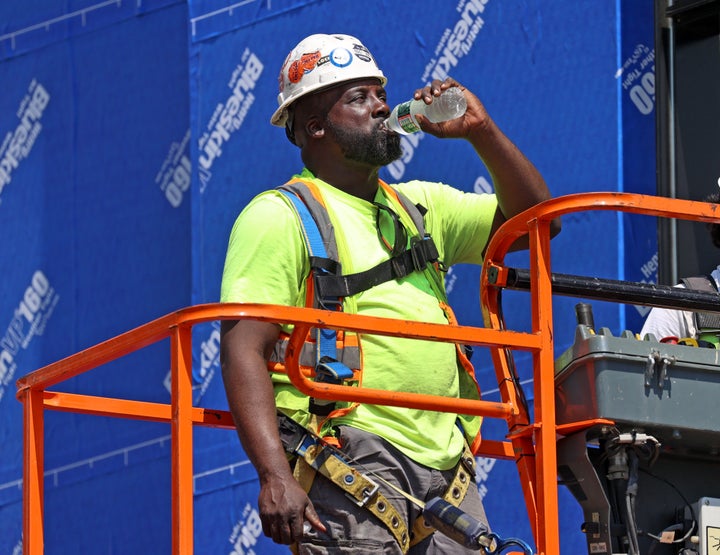The Biden administration unveiled a sweeping rule on Tuesday to protect American workers from extreme heat — an already deadly threat that is becoming worse as climate change drives up temperatures around the globe.
The long-anticipated regulation from the Occupational Safety and Health Administration would, if finalized, establish the nation’s first-ever federal safety standard for excessive heat in both indoor and outdoor workplaces. It is expected to cover some 36 million workers — agricultural laborers, roofers and warehouse workers, to name a few — and dramatically curb heat-related injuries and deaths, the administration said.
The move comes amid dangerous heat warnings across much of the U.S. South, Midwest and West and on the heels of the hottest year in recorded history.
An estimated 2,302 heat-related deaths were recorded in the U.S. last year, up from 1,722 in 2022 and 1,602 in 2021. An average of 33 heat-related workplace deaths and 3,389 injuries and illnesses occurred each year from 1992 to 2020, although the U.S. Bureau of Labor Statistics said those numbers are “likely vast underestimates.”

Boston Globe via Getty Images
The new rule requires employers to implement a variety of safety measures once the heat index reaches certain thresholds. At 80 degrees, workers must be provided with access to water and shaded or indoor rest areas, as well as paid rest breaks as required to prevent overheating. At 90 degrees, the proposed rule mandates a paid 15-minute rest break every two hours and requires employers to monitor workers for signs of heat-related illness. Additionally, new or returning employees must be given multiple days to acclimate to jobs that expose them to high temperatures.
“Workers all over the country are passing out, suffering heat stroke and dying from heat exposure from just doing their jobs, and something must be done to protect them,” Douglas Parker, the assistant secretary for OSHA, said in a statement Tuesday. “Today’s proposal is an important next step in the process to receive public input to craft a ‘win-win’ final rule that protects workers while being practical and workable for employers.”
Whether the workplace heat protections ever see the light of day could hinge on the upcoming presidential election. The rule is not expected to be finalized until 2026, Politico reported. And while former President Donald Trump often touts himself as pro-worker, he has a long record of siding with corporate employers and has promised to dismantle many of President Joe Biden’s climate and environmental policies if elected to a second term in office.
In Trump’s home state of Florida, Republican Gov. Ron DeSantis (R) recently signed into law a bill that blocks heat safety measures (including water and shade breaks) for workers in the state, as HuffPost previously reported. Unions and workplace safety advocates warned that the Republican-led effort would lead to worker fatalities. Texas passed similar legislation last year.
Only a handful of states, including California, Oregon and Washington, have heat protections for workers.
Teresa Romero, president of the United Farm Workers union, applauded Tuesday’s announcement but said it was “a bittersweet moment for farm workers.”
“Every significant heat safety regulation in America at the state, and now federal, level was written in the blood of farm workers. Every year farm workers are killed by heat — with known deaths likely drastically outnumbered by the unknown, uncounted deaths,” she said in a statement. “Today, the federal government put itself on the right side of history by seeking, for the first time, to establish the precedent that every worker in America has the right to shade, water, and rest while working in temperatures that could kill them.”
The rule, if finalized, is all but certain to draw legal challenges, and the Supreme Court just made it harder for federal agencies to enact and defend new rules and regulations. In a 6-3 decision, conservatives on the court overturned a 40-year precedent that afforded agencies broad discretion to craft regulation, effectively shifting federal regulatory power to judges.

